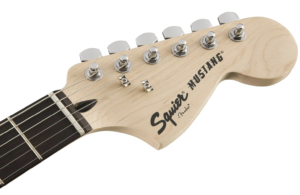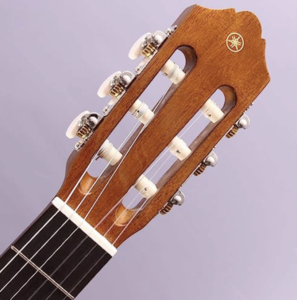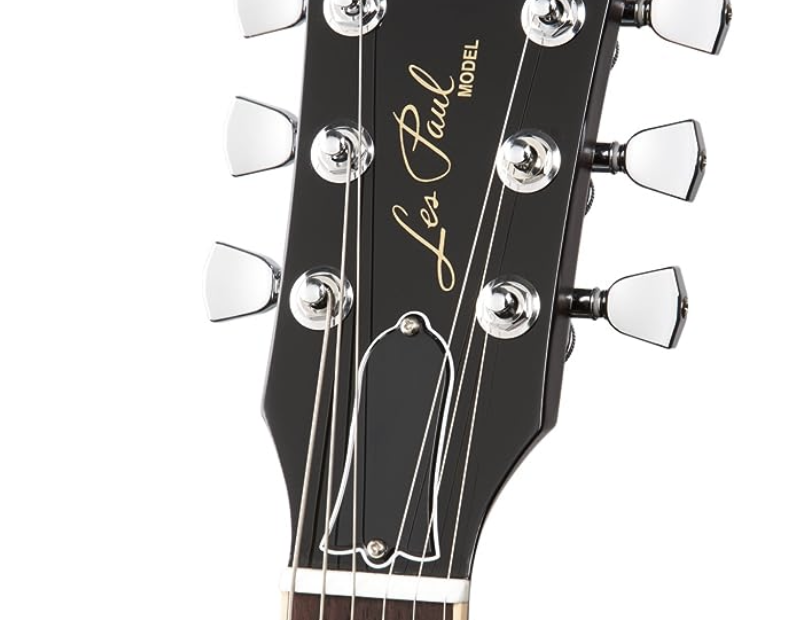The guitar headstock is not merely a functional component of a musical instrument; it is the visual signature that defines the instrument’s identity. With its distinctive shape, logos, and tuning pegs, the headstock not only holds the strings in place but also tells a story of craftsmanship, brand heritage, and the player’s musical journey. Let’s delve into the fascinating world of guitar headstocks and discover the significance they hold in the realm of music.
Aesthetics and Brand Identity:
 The headstock of a guitar is often the first thing that catches the eye of a musician or an audience. Guitar makers take great care in designing headstocks that embody their brand’s essence and identity. Each guitar manufacturer has its unique headstock shape, ranging from the classic designs of Fender’s Stratocaster and Telecaster to the iconic Gibson Les Paul and SG styles. These shapes not only contribute to the aesthetics of the guitar but also act as a symbol of brand recognition and history.
The headstock of a guitar is often the first thing that catches the eye of a musician or an audience. Guitar makers take great care in designing headstocks that embody their brand’s essence and identity. Each guitar manufacturer has its unique headstock shape, ranging from the classic designs of Fender’s Stratocaster and Telecaster to the iconic Gibson Les Paul and SG styles. These shapes not only contribute to the aesthetics of the guitar but also act as a symbol of brand recognition and history.
Tuning Mechanism:
The primary function of the headstock is to house the tuning pegs or machine heads. These small gears, usually arranged in sets of three or six, are essential for adjusting the tension of the strings and tuning each note accurately. Guitarists rely on these tuning pegs to maintain the right pitch for each string, ensuring that the instrument sounds its best during performances and practice sessions.
Also Read:
7 Best Clip On Guitar Tuner Options
Guitar Paint: Enhancing and Protecting Your Instrument
Selecting the Best Guitar Pick
Guitar Anatomy: Understanding Guitar Components
Guitar Wireless System: Unleashing Freedom
The 8-String Guitar: Expanding Your Possibilities
Signature Logos and Inlays:
Guitar headstocks often display the manufacturer’s logo, creating an instant connection between the instrument and its maker. For some players, a brand’s logo holds significant meaning, representing quality, craftsmanship, and musical heritage. Additionally, many guitars feature unique inlays or designs on the headstock, adding a touch of personalization or artistic flair.
Different Headstock Shapes:
 There is a wide variety of headstock shapes, each with its own character and function. The most common styles include:
There is a wide variety of headstock shapes, each with its own character and function. The most common styles include:
- Fender-style: The Fender Stratocaster and Telecaster headstocks have a sleek, simple design with six in-line tuning pegs. They are known for their practicality and tuning stability.
- Gibson-style: Gibson guitars often feature a more elaborate, symmetrical headstock design with three tuning pegs on each side. They are renowned for their distinctive look and are favored by many rock and blues players.
- PRS-style: Paul Reed Smith (PRS) guitars boast a unique headstock shape with distinctive angles, representing a blend of modern and classic aesthetics.
- Acoustic-style: Acoustic guitars typically have a slotted headstock, which provides a vintage and elegant appearance. Some manufacturers, like Taylor and Martin, have their own signature headstock designs.
The Headstock as a Storyteller:
Beyond its functional aspects, the guitar headstock narrates the instrument’s history, its maker’s legacy, and the countless songs and melodies it has played a part in creating. A player’s relationship with their instrument often starts with the captivating design of the headstock, leading to a lifelong musical journey.
The guitar headstock is not merely a functional component of a musical instrument; it is the visual signature that defines the instrument’s identity. With its distinctive shape, logos, and tuning pegs, the headstock not only holds the strings in place but also tells a story of craftsmanship, brand heritage, and the player’s musical journey. Let’s delve into the fascinating world of guitar headstocks and discover the significance they hold in the realm of music.
 Aesthetics and Brand Identity:
Aesthetics and Brand Identity:
The headstock of a guitar is often the first thing that catches the eye of a musician or an audience. Guitar makers take great care in designing headstocks that embody their brand’s essence and identity. Each guitar manufacturer has its unique headstock shape, ranging from the classic designs of Fender’s Stratocaster and Telecaster to the iconic Gibson Les Paul and SG styles. These shapes not only contribute to the aesthetics of the guitar but also act as a symbol of brand recognition and history.
Tuning Mechanism:
The primary function of the headstock is to house the tuning pegs or machine heads. These small gears, usually arranged in sets of three or six, are essential for adjusting the tension of the strings and tuning each note accurately. Guitarists rely on these tuning pegs to maintain the right pitch for each string, ensuring that the instrument sounds its best during performances and practice sessions.
Signature Logos and Inlays:
Guitar headstocks often display the manufacturer’s logo, creating an instant connection between the instrument and its maker. For some players, a brand’s logo holds significant meaning, representing quality, craftsmanship, and musical heritage. Additionally, many guitars feature unique inlays or designs on the headstock, adding a touch of personalization or artistic flair.
Different Headstock Shapes:
There is a wide variety of headstock shapes, each with its own character and function. The most common styles include:
- Fender-style: The Fender Stratocaster and Telecaster headstocks have a sleek, simple design with six in-line tuning pegs. They are known for their practicality and tuning stability.
- Gibson-style: Gibson guitars often feature a more elaborate, symmetrical headstock design with three tuning pegs on each side. They are renowned for their distinctive look and are favored by many rock and blues players.
- PRS-style: Paul Reed Smith (PRS) guitars boast a unique headstock shape with distinctive angles, representing a blend of modern and classic aesthetics.
Acoustic-style Headstocks
Acoustic guitars come in various shapes and sizes, and their headstocks are no exception. The headstock is the top portion of the guitar where the tuning pegs are located. Different acoustic guitar headstock designs offer unique features, aesthetics, and functionalities. Here are some common types of acoustic guitar headstocks:
- Traditional Slotted Headstock: This type of headstock is commonly found on classical guitars. It features long, narrow slots for each string, and the strings are inserted through these slots before being wound around the tuning pegs. Slotted headstocks often give a classical and elegant look to the guitar.
- Solid Headstock: This is the most common type of headstock found on steel-string acoustic guitars. It has a solid design, with the tuning pegs attached to the face of the headstock. The strings pass through small holes on the headstock face and are wound around the tuning pegs.
- Reverse Headstock: Some acoustic guitars, especially electric-acoustic models, may feature a reverse headstock, where the tuners are positioned on the side opposite to the standard configuration. This design can provide better string tension and improve tuning stability.
- Slotted Solid Headstock: This is a combination of features from slotted and solid headstocks. It has the look of a slotted headstock but without the long slots. Instead, it has small holes for each string, similar to a solid headstock.
- 3+3 Headstock: This headstock design is common on many acoustic guitars, especially those inspired by classic dreadnought or OM shapes. It features three tuning pegs on each side of the headstock, forming a symmetrical pattern.
- 6-in-line Headstock: Often seen on acoustic guitars with a more modern design, the 6-in-line headstock has all six tuning pegs in a single row on one side of the headstock. This design is popular among players who prefer a sleek and streamlined look.
- Slotted 6-in-line Headstock: A variation of the 6-in-line headstock, this design features slots for each string instead of small holes. It is less common on acoustic guitars but can add a touch of uniqueness to the instrument.
- Cutaway Headstock: Some acoustic guitars with cutaway bodies also have a corresponding cutaway on the headstock. This design allows for easier access to higher frets and is commonly found on acoustic-electric guitars.
The Headstock as a Storyteller:
Beyond its functional aspects, the guitar headstock narrates the instrument’s history, its maker’s legacy, and the countless songs and melodies it has played a part in creating. A player’s relationship with their instrument often starts with the captivating design of the headstock, leading to a lifelong musical journey.
In conclusion, the guitar headstock is a powerful symbol in the world of music. Its design, tuning mechanism, and logos encapsulate the essence of the instrument, its maker, and its player.
